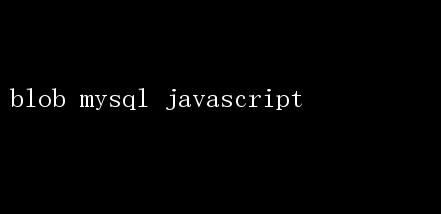Blob数据处理在MySQL中的JavaScript应用
资源类型:wx-1.com 2025-06-11 18:38
blob mysql javascript简介:

Blob Storage in MySQL Integration with JavaScript: Unlocking Seamless Data Management In the ever-evolving landscape of data management and storage, integrating various technologies to create a cohesive and efficient system is paramount. Among these technologies, Blob(Binary Large Object) storage in MySQL, when coupled with JavaScript, offers a powerful combination for handling diverse data types, particularly those that are large in size, such as images, audio files, videos, and other binary data. This article delves into the intricacies of Blob storage in MySQL, its integration with JavaScript, and the myriad benefits it brings to modern applications. Understanding Blob Storage in MySQL MySQL, a relational database management system(RDBMS), is renowned for its robust data storage and retrieval capabilities. Traditionally, MySQL has been used to store structured data, but with the introduction of Blob data types, it has extended its functionality to accommodate large binary objects. Blob stands for Binary Large Object, and it is designed to store large amounts of binary data within a database table. MySQL supports four types of Blob fields, each differing in size capacity: -TINYBLOB: Up to 255 bytes. -- BLOB (or MEDIUMBLOB in some contexts): Up to65,535 bytes(64 KB). -MEDIUMBLOB: Up to 16,777,215 bytes(16 MB). -LONGBLOB: Up to 4,294,967,295 bytes(4 GB). The choice of Blob type depends on the expected size of the data to be stored. For instance, storing thumbnails might require TINYBLOB, whereas full-resolution images or short videos would benefit from BLOB or MEDIUMBLOB, and extensive multimedia content would necessitate LONGBLOB. The Need for Blob Storage The integration of Blob storage within a relational database like MySQL serves several purposes: 1.Data Integrity and Consistency: By storing binary data directly in the database, applications can maintain referential integrity and ensure that related data remains synchronized. This is particularly useful in scenarios where metadata about the Blob(e.g., filename, creation date, user ID) is also stored in the same database. 2.Transactional Support: MySQL offers ACID(Atomicity, Consistency, Isolation, Durability) properties for transactions, ensuring that Blob data manipulations are atomic and consistent. This is critical for applications requiring high data integrity. 3.Simplified Backup and Recovery: With all data, including Blobs, stored within the database, backup and recovery processes are streamlined. Database snapshots or traditional backup tools can encapsulate both structured and unstructured data. 4.Performance Optimization: Depending on the use case, storing Blobs in the database can offer performance benefits. For example, in web applications, serving static content directly from the database can reduce the overhead of managing multiple storage systems and potential network latency between the application server and external storage. JavaScript: The Glue for Seamless Integration JavaScript, with its versatility and widespread adoption across web and server-side environments, serves as the perfect language for integrating Blob storage in MySQL. Whether youre working with Node.js on the server or vanilla JavaScript in the browser, JavaScripts ability to handle asynchronous operations, manipulate data, and interact with external APIs makes it ideal for managing Blob data. Client-Side Interaction with Blobs In web applications, the client-side JavaScript often deals with Blobs when handling file uploads. Users can select files via`` elements, and JavaScript can then read these files as Blob objects. Using the FileReader API, developers can convert Blobs into base64 strings or ArrayBuffer objects for transmission to the server. javascript // Example of reading a file as a Blob and converting it to base64 const fileInput = document.querySelector(input【type=file】); fileInput.addEventListener(change, async(event) =>{ const file = event.target.files【0】; const reader = new FileReader(); reader.readAsDataURL(file); reader.onloadend =() =>{ const base64String = reader.result.split(,)【1】; // Send base64String to the server for storage in MySQL }; }); Server-Side Integration with Node.js